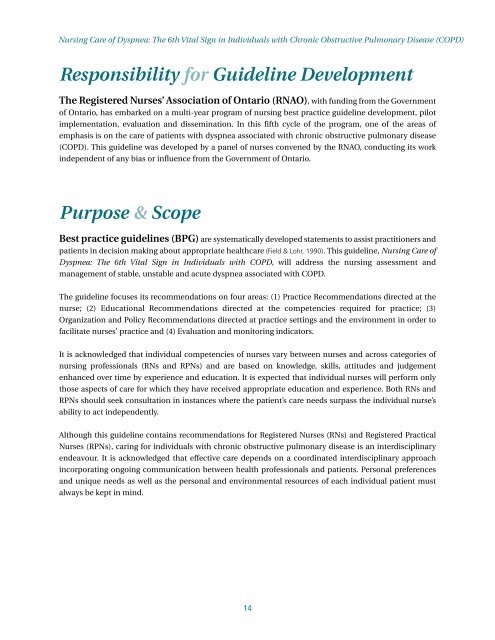Nursing Care of Dyspnea: The 6th Vital Sign in Individuals with ...
Nursing Care of Dyspnea: The 6th Vital Sign in Individuals with ...
Nursing Care of Dyspnea: The 6th Vital Sign in Individuals with ...
You also want an ePaper? Increase the reach of your titles
YUMPU automatically turns print PDFs into web optimized ePapers that Google loves.
<strong>Nurs<strong>in</strong>g</strong> <strong>Care</strong> <strong>of</strong> <strong>Dyspnea</strong>: <strong>The</strong> <strong>6th</strong> <strong>Vital</strong> <strong>Sign</strong> <strong>in</strong> <strong>Individuals</strong> <strong>with</strong> Chronic Obstructive Pulmonary Disease (COPD)Responsibility for Guidel<strong>in</strong>e Development<strong>The</strong> Registered Nurses’ Association <strong>of</strong> Ontario (RNAO), <strong>with</strong> fund<strong>in</strong>g from the Government<strong>of</strong> Ontario, has embarked on a multi-year program <strong>of</strong> nurs<strong>in</strong>g best practice guidel<strong>in</strong>e development, pilotimplementation, evaluation and dissem<strong>in</strong>ation. In this fifth cycle <strong>of</strong> the program, one <strong>of</strong> the areas <strong>of</strong>emphasis is on the care <strong>of</strong> patients <strong>with</strong> dyspnea associated <strong>with</strong> chronic obstructive pulmonary disease(COPD). This guidel<strong>in</strong>e was developed by a panel <strong>of</strong> nurses convened by the RNAO, conduct<strong>in</strong>g its work<strong>in</strong>dependent <strong>of</strong> any bias or <strong>in</strong>fluence from the Government <strong>of</strong> Ontario.Purpose & ScopeBest practice guidel<strong>in</strong>es (BPG) are systematically developed statements to assist practitioners andpatients <strong>in</strong> decision mak<strong>in</strong>g about appropriate healthcare (Field & Lohr, 1990). This guidel<strong>in</strong>e, <strong>Nurs<strong>in</strong>g</strong> <strong>Care</strong> <strong>of</strong><strong>Dyspnea</strong>: <strong>The</strong> <strong>6th</strong> <strong>Vital</strong> <strong>Sign</strong> <strong>in</strong> <strong>Individuals</strong> <strong>with</strong> COPD, will address the nurs<strong>in</strong>g assessment andmanagement <strong>of</strong> stable, unstable and acute dyspnea associated <strong>with</strong> COPD.<strong>The</strong> guidel<strong>in</strong>e focuses its recommendations on four areas: (1) Practice Recommendations directed at thenurse; (2) Educational Recommendations directed at the competencies required for practice; (3)Organization and Policy Recommendations directed at practice sett<strong>in</strong>gs and the environment <strong>in</strong> order t<strong>of</strong>acilitate nurses’ practice and (4) Evaluation and monitor<strong>in</strong>g <strong>in</strong>dicators.It is acknowledged that <strong>in</strong>dividual competencies <strong>of</strong> nurses vary between nurses and across categories <strong>of</strong>nurs<strong>in</strong>g pr<strong>of</strong>essionals (RNs and RPNs) and are based on knowledge, skills, attitudes and judgementenhanced over time by experience and education. It is expected that <strong>in</strong>dividual nurses will perform onlythose aspects <strong>of</strong> care for which they have received appropriate education and experience. Both RNs andRPNs should seek consultation <strong>in</strong> <strong>in</strong>stances where the patient’s care needs surpass the <strong>in</strong>dividual nurse’sability to act <strong>in</strong>dependently.Although this guidel<strong>in</strong>e conta<strong>in</strong>s recommendations for Registered Nurses (RNs) and Registered PracticalNurses (RPNs), car<strong>in</strong>g for <strong>in</strong>dividuals <strong>with</strong> chronic obstructive pulmonary disease is an <strong>in</strong>terdiscipl<strong>in</strong>aryendeavour. It is acknowledged that effective care depends on a coord<strong>in</strong>ated <strong>in</strong>terdiscipl<strong>in</strong>ary approach<strong>in</strong>corporat<strong>in</strong>g ongo<strong>in</strong>g communication between health pr<strong>of</strong>essionals and patients. Personal preferencesand unique needs as well as the personal and environmental resources <strong>of</strong> each <strong>in</strong>dividual patient mustalways be kept <strong>in</strong> m<strong>in</strong>d.14
















